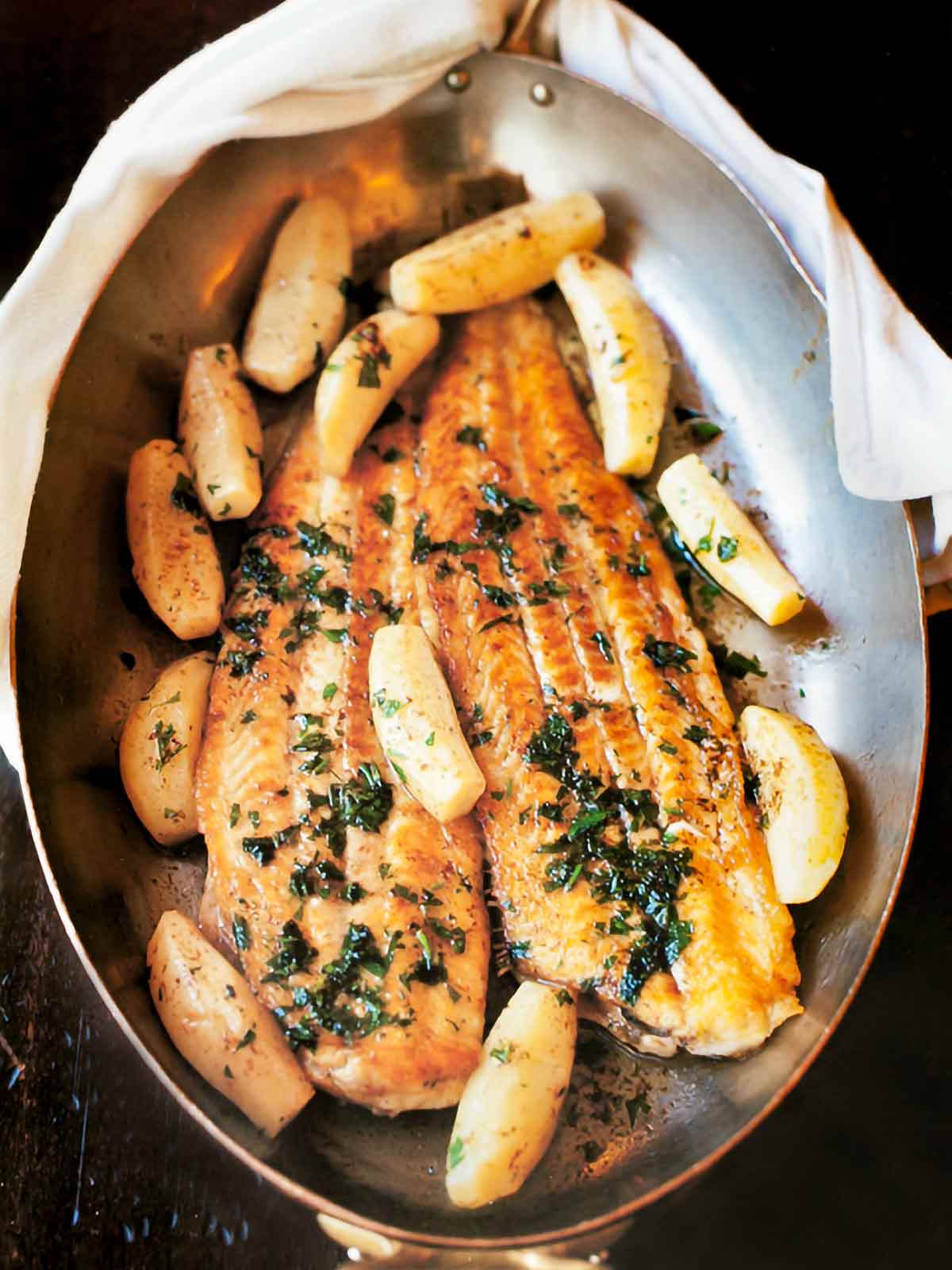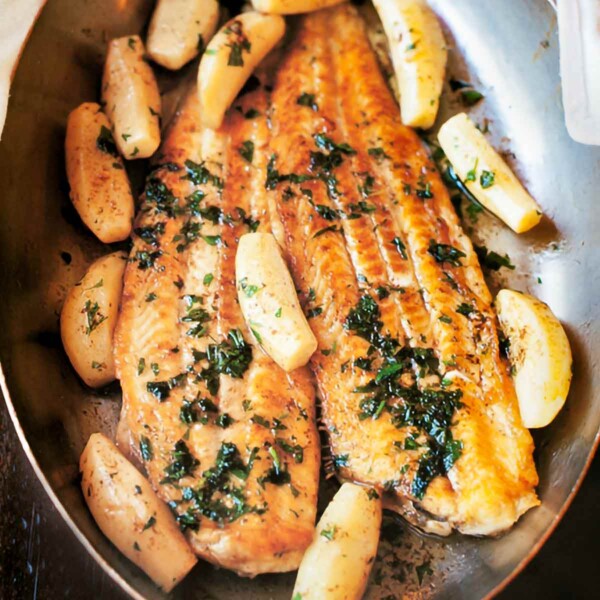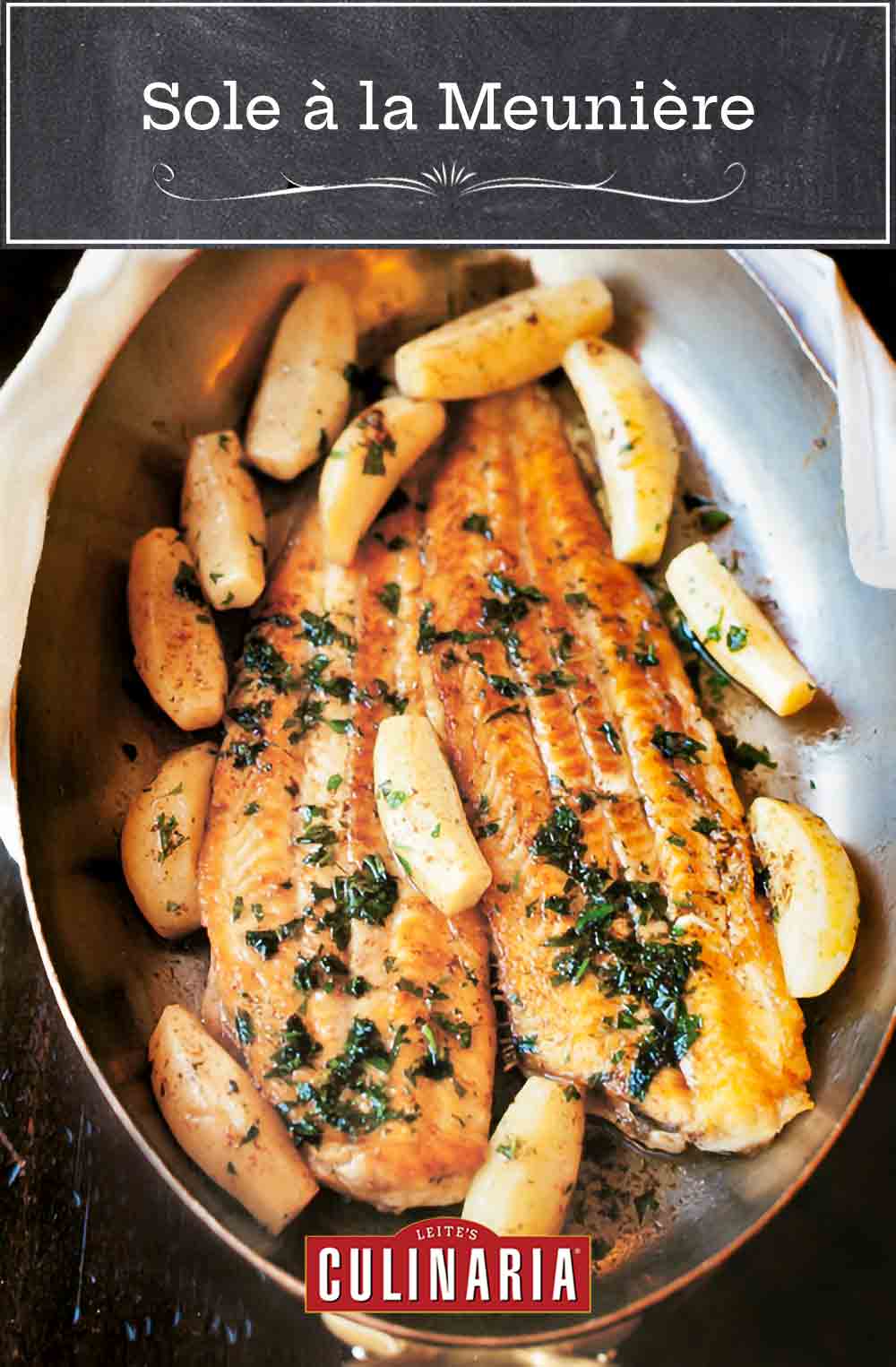
The perfect sole à la meunière is golden brown, which is a result of a harmonious balance between the brown butter and the lemon. It’s a fast and simple dish and characteristic of classic bistro cooking.
–Keith McNally, Riad Nasr and Lee Hanson*What can I substitute for Dover sole?
Dover sole is an unforgettably flavored, albeit unfortunately pricey, fish. Firm and flat, it’s perfect for pan-frying. If you prefer the flavor of butter to the delicate nuance of sole, by all means, sauté the fillets in butter and then drench them in the nutty brown butter sauce. But after paying all that for these fillets, if you prefer to retain a little more of the fish’s innate flavor, then you probably ought to opt for searing them in olive oil. Or do what we do, and substitute the relatively affordable and available flounder to great effect.

Sole à la Meunière
Ingredients
- 6 Dover sole fillets*
- 1 1/4 teaspoons salt
- 1/2 teaspoon freshly ground white pepper, plus more to taste
- 3/4 cup flour
- 6 tablespoons olive oil or unsalted butter
- 1 1/2 sticks (6 oz) unsalted butter
- Juice of 2 lemons, (1/4 cup)
- 1/4 cup roughly chopped flat-leaf parsley leaves
Instructions
- Preheat the oven to 300°F (149°C).
- Use paper towels to pat the sole fillets dry and season both sides with 3/4 teaspoon of the salt and the white pepper.
- Place the flour on a plate and season it with a little more salt and white pepper. Dredge the fillets in the flour and shake off the excess.
- Heat 2 tablespoons of the oil or butter in a large nonstick saute pan over a medium-high flame until hot but not smoking. Add 2 of the fillets and cook until lightly golden on each side, about 3 minutes. Move the fillets to a baking sheet and place in the warm oven to keep warm. Wipe out the pan, add 2 more tablespoons of oil or butter to the pan to heat, and repeat with 2 more fillets. Repeat with the remaining 2 fillets.
- Place all the cooked fillets to the oven. Wipe the pan clean and place over a medium flame. Add the 12 tablespoons of butter to the pan and let it melt, foam, subside, begin to bubble again, and turn a nutty brown. Immediately remove from the heat and carefully add the lemon juice, parsley, the remaining 1/2 teaspoon of salt, and several grindings of white pepper to taste. (Be careful as the butter will most likely spatter angrily when you add the lemon juice.)
- Serve the fillets on warm plates and spoon some of the sauce over each one. Originally published July 18, 2010.

Explore More with AI
Nutrition
Nutrition information is automatically calculated, so should only be used as an approximation.
Recipe Testers’ Reviews
I always jump on any opportunity to cook like Balthazar, and this recipe for sole à la meunière didn’t disappoint. It was delicious. The brown, almost nutty butter sauce provided depth to the lightly sautéed fish, making it a satisfying and substantial meal.
The last two sole a la meunière recipes that we tried were very disappointing. I actually had given up and crossed that dish off of my “menu card.” But then I saw this recipe from The Balthazar Cookbook.
Twelve tablespoons of butter—that’s 1 1/2 sticks—for six Dover sole fillets. We can’t eat this every day, or even every week, but I wonder if we can have it once a month. TIP: You do need to be careful when browning the butter. Butter can burn so easily, but when it’s done correctly—wow. This was absolutely delicious.












It was a wonderfully delicate dish with Dover sole, and we cooked a little extra fish to have in gently scrambled eggs the next morning. Not an everyday amount of butter, but a lovely treat on a Friday night.
Completely agree with you, Irene. A little rich for every day, but lovely for a special occasion. And I am so relieved to hear that I’m not the only one who cooks extra fish to have with eggs in the a.m. Have done that ever since my first trip to Jamaica, where I was hooked. Many thanks for taking the time to share….